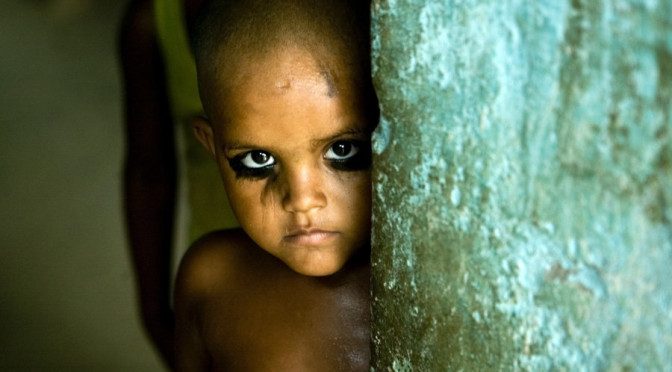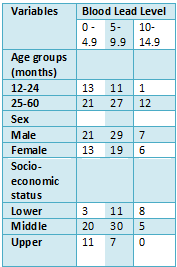
66 percent of Children tested had more than 5 Blood Lead Level
In Cities in India, people are aware that the environment is polluted and that Lead is one of the pollutants. During the Lead in Maggi controversy, consumers argued that compared to the other pollutants in the environment, Lead in Maggi was miniscule. In India, unlike in US there is no mandatory test among consumers to figure out lead toxicity in children. Blood Lead Level (BLL) more than 5 can cause health, growth, neurological and mental problem for children. There is very little study in India to figure out the BLL of consumers in India among those who are not directly at risk from Lead pollution.
High BLL among Middle and Lower Class
[two_thirds]Recently in a study conducted by Lead Activists and Doctors in Banglore, among inpatients aged less than Five, 66% of the children had BLL <5 μg/dl, which is considered as level of concern as per Centre for Diseases Control and Prevention. The patients have no direct risk of lead exposure. Along with BLL done on the children, questionnaire was supplied to the parent to know about their awareness about lead poisoning. 100 children belonged to the lower, middle and the higher income group. The children with the High BLL belonged to the lower income group more than the middle and the higher income group.[/two_thirds]
[third]With 66 out of 100 children showing high BLL — with no known direct risks to Lead exposure — proves that there is an urgent requirement of conducting BLL test among children in cities in India.[/third]
Very little awarness of sources of Lead Exposure
The study showed that the awareness of the sources of lead toxicity and the effect of lead poisoning is very poor among consumers in India. Consumers are aware of Lead hazard from paints and batteries, but they were unaware of the lead exposure from soil, dust, groundwater and vehicular traffic. Apart from the occupational exposure to Lead, water, contaminated food and consumer items are also major sources of Lead. In Delhi there were media reports about Lead in vegetables grown near contaminated water bodies.
[two_thirds]According to the study ” ……… build up of Lead
in the environmental compartments is still an issue of high
exposure risk in India, inspite of the relatively lesser organized
production and use of Lead as compared to the developed
countries.”[/two_thirds]
[third]Parents were prepared to conduct Lead Testing of their surroundings so as to provide safe environs for the Children.[/third]
Parents prepared for Lead Tests
The study also showed that parents were prepared to conduct Lead Testing of their surroundings so as to provide safe environs for the Children.
With 66 out of 100 children showing high BLL — with no known direct risks to Lead exposure — proves that there is an urgent requirement of conducting BLL test among children in cities in India. And also awareness should be spread among consumers about how to safeguard their children from Lead exposure. The media can be put to use to spread the message. According to studies children exposed to lead have lower IQ which effect their mental development and thereby resulting in a loss to the nation and humanity. As Lead is not required in any amount by the human body, steps must be taken to reduce or eliminate the use of Lead.
In order to reduce the menace of Lead you can also participate in the #StopLeadPoisoning campaign.




To the lifestyletodaynews.com webmaster, Nice post!
Hi lifestyletodaynews.com webmaster, Keep it up!
Hi lifestyletodaynews.com administrator, Thanks for the informative and well-written post!
Hi lifestyletodaynews.com webmaster, You always provide clear explanations and step-by-step instructions.
Dear lifestyletodaynews.com webmaster, Your posts are always informative and well-explained.
Dear lifestyletodaynews.com administrator, Great post!
Dear lifestyletodaynews.com admin, Keep sharing your knowledge!
Hello lifestyletodaynews.com owner, Your posts are always well-received by the community.
Dear lifestyletodaynews.com webmaster, Your posts are always well-supported by facts and figures.
Hello lifestyletodaynews.com webmaster, Keep up the good work!
Hi lifestyletodaynews.com webmaster, Great post!
To the lifestyletodaynews.com owner, You always provide valuable feedback and suggestions.
Hi lifestyletodaynews.com owner, Good job!
Dear lifestyletodaynews.com administrator, You always provide great resources and references.
Dear lifestyletodaynews.com owner, Thanks for the detailed post!
Dear lifestyletodaynews.com administrator, Thanks for the well-researched post!
Hello lifestyletodaynews.com owner, You always provide in-depth analysis and understanding.
Hi lifestyletodaynews.com owner, Your posts are always well-supported by research and data.
Hi lifestyletodaynews.com admin, Thanks for the detailed post!
Hi lifestyletodaynews.com webmaster, Your posts are always well-referenced and credible.
Hello lifestyletodaynews.com webmaster, Keep up the good work, admin!
To the lifestyletodaynews.com owner, Good to see your posts!
Hi lifestyletodaynews.com administrator, Great content!
Hi lifestyletodaynews.com admin, Your posts are always well-referenced and credible.
Hi lifestyletodaynews.com webmaster, Well done!
Hello lifestyletodaynews.com administrator, Thanks for the comprehensive post!
To the lifestyletodaynews.com owner, Your posts are always well-supported by research and data.
Hi lifestyletodaynews.com owner, Your posts are always well-delivered and engaging.
Hi lifestyletodaynews.com admin, Thanks for the well-researched and well-written post!
Dear lifestyletodaynews.com owner, Your posts are always insightful and valuable.